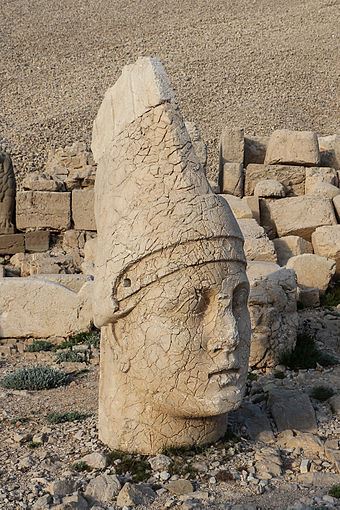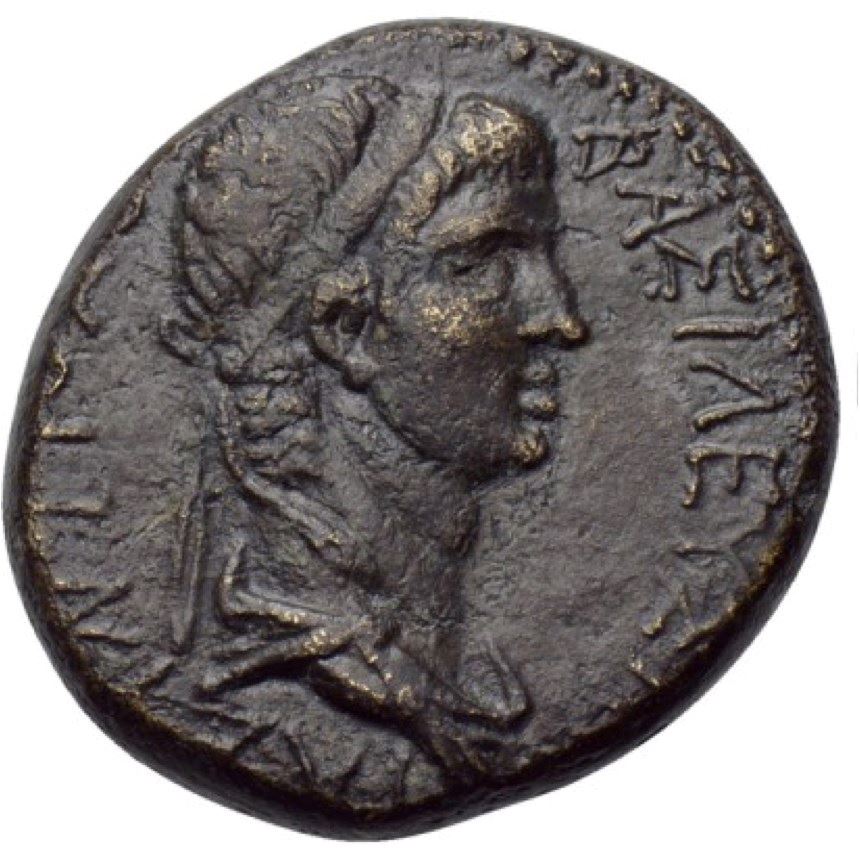The Kingdom of Commagene was an ancient kingdom located around the city of Samosata. It has been characterized as a "buffer state" between Armenia, Parthia, Syria, and Rome; culturally, it seems to have been correspondingly mixed. The name is probably derived from Kummuh, the Iron Age name of its capital..
Little is known of the region of Commagene prior to the beginning of the 2nd century BC. However, it seems that, from what little evidence remains, Commagene formed part of a larger state that also included the Kingdom of Sophene. This control lasted until c. 163 BC, when the local satrap, Ptolemaeus of Commagene, established himself as independent ruler following the death of the Seleucid king, Antiochus IV Epiphanes.
The Kingdom of Commagene maintained its independence until 17 AD, when it was made a Roman province by Emperor Tiberius. It reemerged as an independent kingdom when Antiochus IV of Commagene was reinstated to the throne by order of Caligula, then deprived of it by that same emperor, then restored to it a couple of years later by his successor, Claudius. The re-emergent state lasted until 72 AD, when the Emperor Vespasian finally and definitively made it part of the Roman Empire
Little is known of the region of Commagene prior to the beginning of the 2nd century BC. However, it seems that, from what little evidence remains, Commagene formed part of a larger state that also included the Kingdom of Sophene. This control lasted until c. 163 BC, when the local satrap, Ptolemaeus of Commagene, established himself as independent ruler following the death of the Seleucid king, Antiochus IV Epiphanes.
The Kingdom of Commagene maintained its independence until 17 AD, when it was made a Roman province by Emperor Tiberius. It reemerged as an independent kingdom when Antiochus IV of Commagene was reinstated to the throne by order of Caligula, then deprived of it by that same emperor, then restored to it a couple of years later by his successor, Claudius. The re-emergent state lasted until 72 AD, when the Emperor Vespasian finally and definitively made it part of the Roman Empire
.JPG)
Ptolemaeus of Commagene was the last satrap and first king of Commagene. He was of Orontid Armenian descent, being related to the king of Sophene Arsames I. His father was King Orontes IV of Armenia, son of Arsames I.
Ptolemaeus started out as Governor - Satrap - of Commagene under the Seleucid rulers Antiochus III, Seleucus IV, Antiochus IV, and Antiochus V Eupator. But when the Seleuc...
Ptolemaeus started out as Governor - Satrap - of Commagene under the Seleucid rulers Antiochus III, Seleucus IV, Antiochus IV, and Antiochus V Eupator. But when the Seleuc...
Sames II was the second king of Commagene. Of Armenian descent, he was the son and successor of Ptolemaeus of Commagene.
Sames reigned as king between 130–109 BC. During his reign, Sames ordered the construction of the fortress at Samosata which is now submerged by water from the Atatürk Dam.
Sames died in 109 BC. His wife was Pythodoris, daughter of the Kings of Pontus, and ...
Sames reigned as king between 130–109 BC. During his reign, Sames ordered the construction of the fortress at Samosata which is now submerged by water from the Atatürk Dam.
Sames died in 109 BC. His wife was Pythodoris, daughter of the Kings of Pontus, and ...
Mithridates I was a king of Orontid Armenian descent who lived during the late 2nd century BC and early 1st century BC. Mithridates was a prince, the son, and successor of King of Commagene, Sames II Theosebes Dikaios.
Before his succession in 109 BC, he married the Syrian Greek Princess Laodice VII Thea as a part of a peace alliance. Mithridates embraced Greek culture. Laodice bore Mi...
Before his succession in 109 BC, he married the Syrian Greek Princess Laodice VII Thea as a part of a peace alliance. Mithridates embraced Greek culture. Laodice bore Mi...
Antiochos I was the most famous king of Commagene. He was the son and probably the only child of King Mithridates I Callinicus and Queen Laodice VII Thea of Commagene. Antiochus was half Armenian, a distant member of the Orontid Dynasty and half Greek.
While the Roman Republic was annexing territories in Anatolia, Antiochos, through skilled diplomacy, was able to keep Commagene indepen...
While the Roman Republic was annexing territories in Anatolia, Antiochos, through skilled diplomacy, was able to keep Commagene indepen...
Mithridates II was king of Commagene from 38 BC and until his death in 20 BC. He wasone of the sons of King Antiochus I Theos of Commagene and Queen Isias Philostorgos of Commagene.
According to Plutarch, he was an ally of the Roman triumvir Mark Antony. In 31 BC, Mithridates personally led his forces to Actium in Greece in support of Antony in the war against Caesar Octavian, the futur...
According to Plutarch, he was an ally of the Roman triumvir Mark Antony. In 31 BC, Mithridates personally led his forces to Actium in Greece in support of Antony in the war against Caesar Octavian, the futur...
Mithridates III was king of Commagene from 20 BC and until his death in 12 BC. He was the son and successor of King Mithridates II of Commagene and Queen Laodice. He was of Armenian and Greek descent.
Very little is known on his life and his reign. When he died in 12 BC, Antiochus III of Commagene became King.
Very little is known on his life and his reign. When he died in 12 BC, Antiochus III of Commagene became King.
Antiochos III was king of Commagene from 12 BC to 17 AD. He was the son and successor of King Mithridates III of Commagene and Iotapa, and of mixed Armenian, Greek and Median descent--the last through his mother. His parents were first cousins.
Very little is known on his life and his reign as King. When Antiochus died in 17 AD, his death created major issues for the kingdom, which was ...
Very little is known on his life and his reign as King. When Antiochus died in 17 AD, his death created major issues for the kingdom, which was ...
Antiochos IV was the last king of Commagene, and reigned between 38–72 as a client king to the Roman Empire. His parents King Antiochus III of Commagene and Queen Iotapa were full-blooded siblings who had married each other. The younger Antiochos himself would marry his full-blooded sister Iotapa.
Antiochus appears to have been very young when his father died in 17. The Roman emperor Ti...
Antiochus appears to have been very young when his father died in 17. The Roman emperor Ti...



